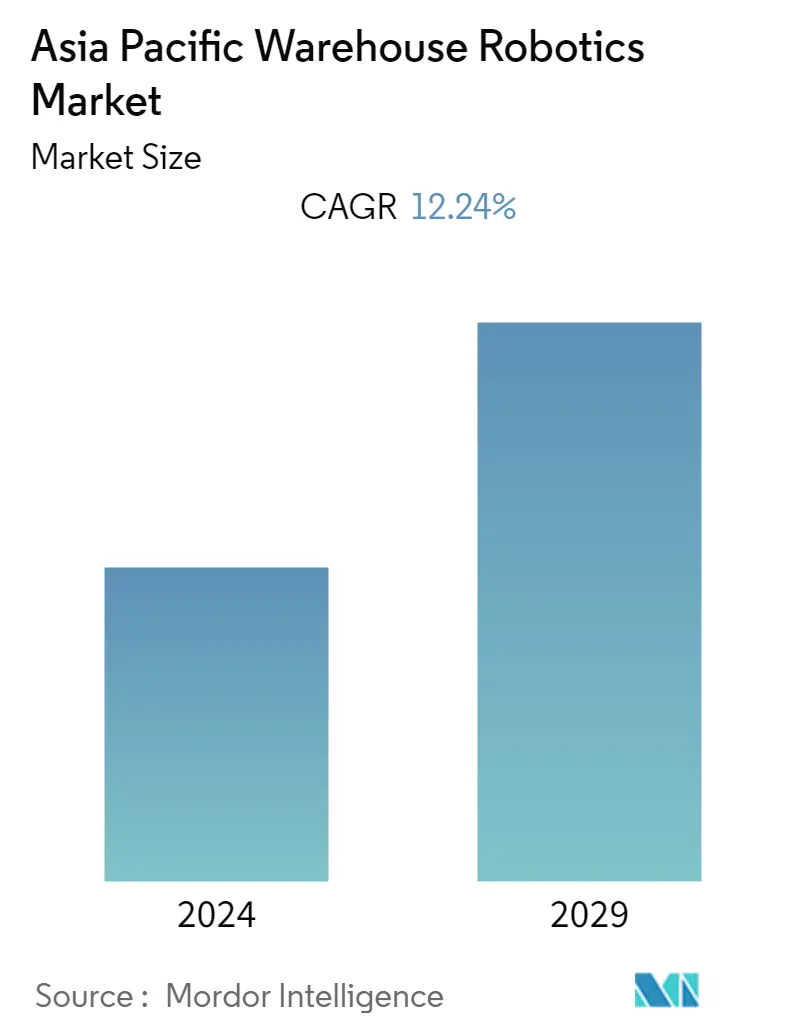Market Size of Asia Pacific Warehouse Robotics Industry

| Study Period | 2019 - 2029 |
| Base Year For Estimation | 2023 |
| Forecast Data Period | 2024 - 2029 |
| Historical Data Period | 2019 - 2022 |
| CAGR | 12.24 % |
| Market Concentration | Low |
Major Players
*Disclaimer: Major Players sorted in no particular order |
Asia Pacific Warehouse Robotics Market Analysis
The market for Warehouse Robotics is expected to reach a CAGR of 12.24% during the forecast period of 2020 - 2025. The manufacturing sector is expected to account for a significant market share and become one of the key contributors in the country, with investments in the industry growing massively. There has been an increasing need for delivering various products in small timeframes, which require efficient inventory management and reverse logistics systems. Significant investments in the e-commerce industry, along with the demand from the ever-growing internet-enabled consumers, are impacting the growth of roller conveyors in Asia-Pacific.
- Companies that already deployed these robots in their warehouses are witnessing the results during the pandemic. JD.com, a Chinese e-commerce giant based out of Wuhan, has been using a fleet of robotic vehicles in its automated warehouses to deliver essential goods to residents stuck at homes and shopping online. The company claims that it witnessed an increase in the daily orders from about 600,000 to nearly double in a single week during the pandemic.
- The South Korean government's measures ensure to boost the country's small and mid-size manufacturing companies, including the establishment of 30,000 smart factories by 2022. The government expects that small and mid-size firms in the manufacturing industry will create 66,000 jobs by automating 50% of their manufacturing facilities and increase KRW 18 trillion (USD 16 billion) of sales.
- Moreover, Japan has continuously maintained its position as the world's top exporter of robots in terms of the value of shipments and the number of operating units. For instance, Fuji Yusoki Kogyo Co. Ltd, Japan-based development and manufacturing of palletizing robots company, has sold over 16,000 robots all over the world. The company has a market share of 63% in the robotic palletizing industry of Japan and more than 20% market share in the world robotic palletizing industry.
- Amid the COVID-19 pandemic, companies in the country are rushing to deploy automation throughout the nation. Emil Hauch Jensen, VP of sales at Mobile Industrial Robots in Shanghai, stated that the company's autonomous robots that can move pallets and heavy loads across warehouses and factories witnessed increased demand across a wide range of industries. Many large players, such as Ford, Airbus, Flex, Honeywell, and DHL, are also responsible for the increasing demand.
Asia Pacific Warehouse Robotics Industry Segmentation
The warehouse is the most vital part of the supply chain process. They perform product transit that starts from the process of the production facility, acknowledgment, organizing, and also the tagging for delivering product on the required address. Warehouse robotics is the adoption of robotics in the warehouse that performs functions like Storage, Packaging, Trans-shipment, and Other Functions. End Users considered under the scope include Food and Beverage, Automotive, Retail, Electrical and Electronics, Pharmaceutical, and Other End Users. The study also provides the impact of COVID-19 on the market.
| Type | |
| Industrial Robots | |
| Sortation Systems | |
| Conveyors | |
| Palletizers | |
| Automated Storage and Retrieval System (ASRS) | |
| Mobile Robots (AGVs and AMRs) |
| Function | |
| Storage | |
| Packaging | |
| Trans-shipments | |
| Other Functions |
| End User | |
| Food and Beverage | |
| Automotive | |
| Retail | |
| Electrical and Electronics | |
| Pharmaceutical | |
| Other End Users |
| Country | |
| China | |
| Japan | |
| South Korea | |
| Rest of Asia-pacific |
Asia Pacific Warehouse Robotics Market Size Summary
The Asia Pacific warehouse robotics market is experiencing significant growth, driven by the increasing demand for automation across various sectors. The manufacturing industry is a major contributor to this expansion, with substantial investments aimed at enhancing efficiency and productivity. The rise of e-commerce and the need for rapid product delivery have further propelled the adoption of robotic systems, particularly in countries like China and South Korea. These nations are leveraging robotics to streamline operations, reduce labor costs, and maintain competitiveness in the global market. The South Korean government's initiatives to establish smart factories and support small and mid-size enterprises are key factors in boosting the country's robotics sector. Similarly, Japan's position as a leading exporter of robots underscores its commitment to automation and technological advancement.
The competitive landscape of the warehouse robotics market in the Asia Pacific region is marked by the presence of several global players, including ABB, Fanuc, Yaskawa, and Kuka. These companies are actively engaging in innovative activities to capture market share and meet the growing demand for automated solutions. The market is characterized by a high degree of competition, influenced by factors such as brand identity and strategic partnerships. The ongoing development of advanced robotic systems, such as Singapore Technologies Engineering's collaboration with Aidrivers for autonomous vehicles, highlights the industry's focus on integrating cutting-edge technology to enhance operational efficiency. As the region continues to embrace automation, the warehouse robotics market is poised for substantial growth, driven by technological advancements and increasing industrial automation.
Asia Pacific Warehouse Robotics Market Size - Table of Contents
-
1. MARKET DYNAMICS
-
1.1 Market Overview
-
1.2 Industry Attractiveness - Porter's Five Forces Analysis
-
1.2.1 Threat of New Entrants
-
1.2.2 Bargaining Power of Buyers
-
1.2.3 Bargaining Power of Suppliers
-
1.2.4 Threat of Substitutes
-
1.2.5 Intensity of Competitive Rivalry
-
-
1.3 Industry Value Chain Analysis
-
1.4 Impact of COVID-19 on the Industry
-
1.5 Market Drivers
-
1.5.1 Increasing Number of SKUs
-
1.5.2 Increasing Investments in Technology and Robotics
-
-
1.6 Market Challenges
-
1.6.1 Stringent Regulatory Requirements
-
1.6.2 Hight Cost
-
-
-
2. MARKET SEGMENTATION
-
2.1 Type
-
2.1.1 Industrial Robots
-
2.1.2 Sortation Systems
-
2.1.3 Conveyors
-
2.1.4 Palletizers
-
2.1.5 Automated Storage and Retrieval System (ASRS)
-
2.1.6 Mobile Robots (AGVs and AMRs)
-
-
2.2 Function
-
2.2.1 Storage
-
2.2.2 Packaging
-
2.2.3 Trans-shipments
-
2.2.4 Other Functions
-
-
2.3 End User
-
2.3.1 Food and Beverage
-
2.3.2 Automotive
-
2.3.3 Retail
-
2.3.4 Electrical and Electronics
-
2.3.5 Pharmaceutical
-
2.3.6 Other End Users
-
-
2.4 Country
-
2.4.1 China
-
2.4.2 Japan
-
2.4.3 South Korea
-
2.4.4 Rest of Asia-pacific
-
-
Asia Pacific Warehouse Robotics Market Size FAQs
What is the current Asia Pacific Warehouse Robotics Market size?
The Asia Pacific Warehouse Robotics Market is projected to register a CAGR of 12.24% during the forecast period (2024-2029)
Who are the key players in Asia Pacific Warehouse Robotics Market?
ABB Limited, Singapore technologies engineering ltd (aethon incorporation), Fanuc Corporation , TOSHIBA CORP. and Yaskawa Motoman (Yaskawa Electric Corporation) are the major companies operating in the Asia Pacific Warehouse Robotics Market.

